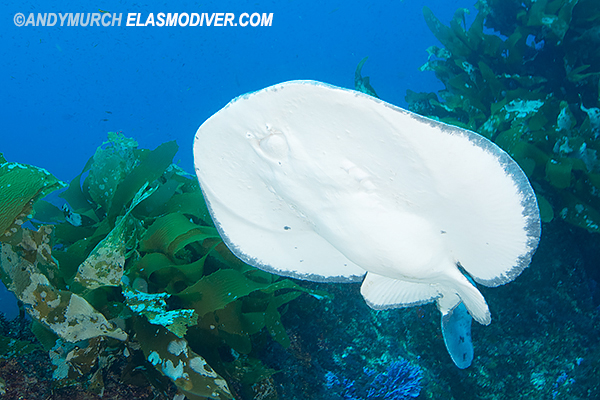

View all available
Pacific Torpedo Ray Pictures
in the
shark picture database
Common Names:
Pacific Torpedo Ray, Pacific Electric Ray, California torpedo ray.
Binomial:
Tetronarce californica.
Family:
Torpedinidae.
Identification:
Body disc slightly wider
than long. Leading edge of pectoral fin disc straight/ bluntly
rounded. Paired kidney shaped electric organs are visible beneath
the skin on either side of the head. Tail short with
well developed upper and lower caudal lobes. Two dorsal fins on tail from
mid base of pelvic fins. First dorsal fin for than twice as large as second. Eyes small.
Spiracles smooth edged. Dorsal coloration slate grey, light grey or
brownish with or with irregular small black spots.
Spots sometimes absent. Underside white.
Size:
Maximum length 140cm.
Habitat:
The Pacific torpedo ray is a bottom dwelling species often
found near rocky reefs from the shallows to 200m. Maximum recorded
depth 425m. There is one record from 17km off Point Pinos Monterey
County, California, where this ray was found swimming 10m below the
surface over water 3km deep.
Distribution:
Western Pacific from Dixon Entrance in
British Columbia, Canada to Vizcaino Bay in Baja California, Mexico.
Recently recorded off the South Kuril Islands in
Eastern Russia.
Most abundant south of Point Conception,
California.
Behavior:
An ambush predator by day. The Pacific torpedo
ray lays in wait on the seafloor until a fish comes within close
enough range then the torpedo ray jumps forward and shocks the fish
with its powerful electric organs. At night
this species actively hunts for benthic animals on the seafloor.
Reproduction:
Ovoviviparous.
the embryos are fed by ingesting a nutrient rich liquid that the mother secretes
into the uteri. 17-20 young per litter. Gestation period unknown.
Conservation Status: Listed as Least Concern
by the IUCN. The Pacific Electric Ray (Torpedo californica) has a
restricted distribution in relatively shallow, inshore waters on the
west coast of North America. Targeted commercial or recreational
fisheries do not threaten it and levels of bycatch appear low.
A small fishery exists for the acquisition of
biological and biomedical research specimens (Love 1996). Small
numbers of animals are harvested, either directed or as bycatch in
bottom-trawls, for their electric organs. The fishery may currently
have as few as two active fishers.
Photographs:
Farnsworth Bank, Catalina Island,
California.
Similar species:
The Pacific torpedo ray is the only
torpedo ray on the west cost. The Peruvian torpedo ray is present in
the Eastern Pacific from Costa Rica southward to Peru. It is a
similar shape but unmarked with dark brown to purple pigmentation.
Reaction to divers:
Easily approached. Virtually ignores divers but may
become aggressive and pursue divers if molested. Divers have reported being shocked.
Diving logistics:
Reasonably common but unpredictable near deeper kelp forests around southern
California. Local divers report this ray as abundant at Farnsworth
bank off the west side of Catalina Island.
Further Reading:
The
pacific electric ray Torpedo (Tetronarce) californica Ayres,
1855, the first of the order Torpediniformes in the waters of
russia, with comments on the formation of its range.
Russian
Journal of Marine Biology. July 2015, Volume 41, Issue 4, pp
295-299
Neer,
J.A. 2005. Tetronarce californica. The IUCN Red List of
Threatened Species 2005: e.T39396A10198408. http://dx.doi.org/10.2305/IUCN.UK.2005.RLTS.T39396A10198408.en
|























